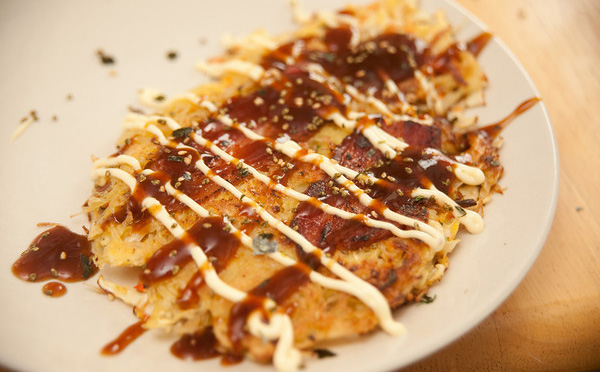
Like many of the world’s greatest everyday foods, okonomiyaki doesn’t sound like much, in theory. I was introduced to these remarkable Japanese pancakes while visiting a friend in Portland, Oregon, a few years ago.
“So,” said our host, Caryn. “I’m making us okonomiyaki for dinner. It’s kind of like a Japanese cabbage and egg pancake.”
This sounded just terrible. It also sounded like a criminal waste of an opportunity to dine out in a new city. I was secretly petulant.
But — as often the case — modest expectations are rewarded with transcendent results. A properly done okonomiyaki is a symphony of flavor and texture that will startle the unitiated. Caryn’s dinner was amazing, first simply because it was delicious, and second because it was utterly unlike anything I’d ever eaten before.
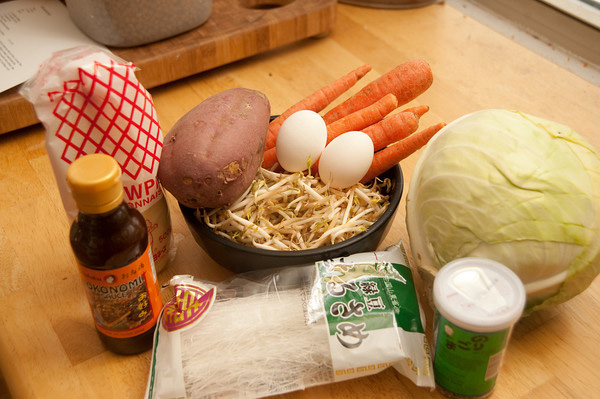
From the crisp crunch of the cabbage and other vegetables, to the slender, delicate bean thread noodles, to the pungent kick of seaweed and bonito from the furikake flakes, to the creamy smoothness of the Japanese mayonnaise, to the sweet, tangy BBQ-like flavors of the okonomi sauce, to the mellow savory pork flavor of the uncured bacon, this particular adaptation of okonomiyaki is as crowded with flavor as your typical Japanese urban train station is crowded with people on a Monday morning.
Nothing, however, clashes. It’s a coordinated mix.
Moreover: Once you’re comfortable with this recipe, you’ve got a lot of leeway to experiment. Meatless okonomiyaki would be a snap. The veggie mix is easily adjusted, and the toppings (furikake, okonomi sauce, mayo) can be applied (or not) as suits personal taste. You can try okonomiyaki at a number of area restaurants — Obento Ya, Midori’s Floating World Cafe, and Moto-i all offer versions, which vary in flavor and style considerably.
Shopping is key to a good okonomiyaki experience. Bacon would over-salt this dish; uncured bacon works considerably better. We use uncured Lorentz bacon from Seward Co-op.
Finding the okonomi sauce, Japanese style mayonnaise, bean thread noodles, and furikake can be challenging. Here’s one solution.
1. Go to United Noodles (2015 East 24th Street, Minneapolis).
2. Look for the Japanese food aisles (to the right of the main entrance, but not all the way back with the Korean / Chinese / Indian aisles).
3. Pick up the following items (pictured below): okonomi sauce; Kewpie mayonnaise; nori goma style furikake. There are a lot of styles of furikake, so browse patiently.
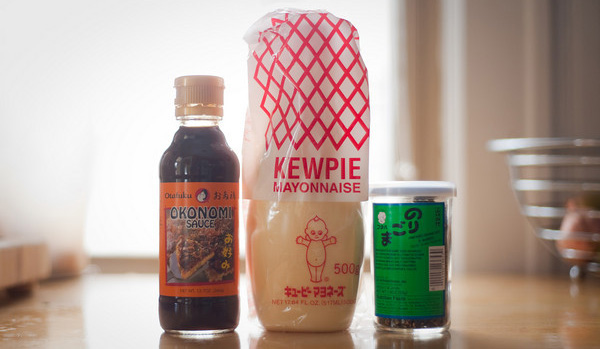
Also on the list for United Noodles: a package of bean thread noodles (pictured, right; they say “bean-jelly strips ryokuto harusame” on the back.)
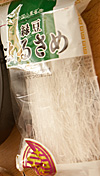
With this stuff, plus the uncured bacon and a variety of easy to find veggies and pantry staples, you’re in business.
But before we get to the recipe, a bit of background.
I wrote to our Portland host, Dr. Caryn Entine Avery, and asked if she had a few words to share about the dish. Lo and behold, she offered an entertaining and enlightening minor dissertation, which is reprinted here:
“Okonomiyaki translates literally to “fried whatever you like” and there are two main styles: Hiroshima style and Kansai (Osaka/Kyoto area) style. The recipe that I have is kind of a mix of both, but more a bastardization of the Kansai style.
“The main difference is the way you make the pancake, and that the Hiroshima style includes noodles, which I like. Although I lived in Hiroshima and kind of like their style better, it is practically impossible to make at home. It requires a huge flat grill space: they would sort of stir-fry the veggies and noodles separately, fry the meat and pour a thin pancake of the batter (without anything in it) over the meat first, then pile up the veggies mixture and noodles on top of the pancake, overlay a second thin pancake on top, then sauce it up.

“So in Hiroshima, the restaurants I went to that served it were small with a huge central grill with a chef standing in the middle. You sit at a bar stool at the grill, they make it in front of you and then you eat it off the grill with a little metal shovel (and desperately try not to burn your mouth).
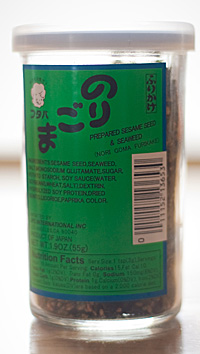
“The Kansai style has the veggies mixed into the batter, and is made more or less like my recipe, but usually without noodles. Often there are also chunks of shrimp or other seafood mixed in. We went out for Okonomiyaki in Nara which is in the Kansai region, and there they had individual tables with little hibachi grills built into the table. You picked your style (what meat/veggies/etc) you wanted, and the waitress brings over a bowl of batter with all the stuff on top so you can see it, then mixes it together and makes it for you on your grill. She paints some thinner sauce on while it’s cooking, then she (and you) add more of the thicker sauce (like what you have) once it’s done.
“In actuality, they don’t put Furikake on top but shredded dried seaweed and Bonito fish flakes, but I use the Furikake because I like it and it simulates that flavor pretty well without having to buy too many additional things.
“Overall I think my recipe is a pretty good representation of the Kansai style that we had when we were there in the spring. It was created by trial and error – when I was in Japan in ’97 I loved the Hiroshima okonomiyaki and I really wanted to learn how to make it. My host family introduced me to the Kansai style and showed me a basic recipe at home because Hiroshima style is way too hard. I wrote down the ingredients but didn’t have any measurements or ratios, and I also didn’t know what to call or how to make some of the things they were using (Dashi was one of them, I later found out).
“Then I put away my journal and forgot about it. I recreated it for the first time when we were living in Portland almost 10 years after that trip because I was so excited that we had a Japanese grocery store that I went looking through my journals for the recipes I had written. After a while I figured out an egg/flour/dashi ratio that seemed to work well, and some veggie ingredients that I liked.”
Dr. Avery’s Okonomiyaki
yields 6 medium pancakes
(note: the original recipe makes five; we found six were easier to manage — but this is very easy to modify and play with, as you’ll soon discover)
4 eggs
2 tbsp water
¾ c flour
Salt
Pepper
4 c shredded cabbage
1 ½ c shredded carrots
1 c shredded yam
1 c bean sprouts
1 package bean thread noodles
12 strips thin-sliced side pork (about ⅓-½ lb)
Place bean thread noodles in a small bowl with the hottest tap water you have. Let soak. Beat eggs and water in a large bowl. Add flour slowly, whisking to make a smooth paste-like batter. Season lightly with salt and pepper. Shred veggies. Drain noodles when softened. Snip into shorter lengths into the paste. Add the shredded veggies and stir until everything is well coated by batter.
In a large pan over medium-high heat, fry 6 strips of side pork until done on one side. Flip, group into 3 groups of 2, and cover each group with a scoop of batter. Flatten out the pancakes, and cook until the edges look done, 4-5 minutes. Flip and cook 7-8 minutes more, until the veggies and egg look cooked through (flip again if not done). Repeat with remaining 6 strips of pork and batter.
Serve hot with Okonomi sauce (Japanese barbeque sauce, similar to yakisoba sauce in a pinch), Japanese style mayonnaise (caution — a little goes a long way), and Furikake (Japanese sesame-seed based condiment – this comes in different flavors, my favorite is traditional nori-goma). These refrigerate well for a few days, and are great re-heated in a toaster oven.
Notes: These are literally “whatever you like, fried” so feel free to use any veggies you want (though the cabbage and carrots are pretty much staples), substitute beef or seafood for pork (chopped shrimp mixed in is good), or anything else that strikes your fancy. Side pork is basically uncured bacon, and can be hard to find. You can use regular bacon in a pinch, but it will obviously be a lot saltier. You can also use thin pork chops, pounded even thinner for a different effect, or buy spare ribs and try to slice them really, really thin.

Wow, does this sound and look good! When you say “yam” do you mean the moist, orange-fleshed sweet potatoes such as garnet yams, or do you mean a true yam (which is completely different)? Any info you can give will help me in my shopping, coz I’m gonna make this tonight! Thanks for posting. And BTW, the Heavy Table has really been outstanding lately.
Hi Teresa,
I used a Japanese yam from United Noodle (which is neither moist, nor orange-fleshed — I’m guessing it’s akin to or, in fact, a true yam.) The beauty of this recipe, however, is that it has a lot of flex to it — as long as you keep the proportions more or less aligned, you’ll be hard pressed to come up with something that isn’t delicious. Good luck with your cookery, I hope it turns out great… let us know if you have any insights into method or ingredients.
James
Satay-2-Go, in Apple Valley, also serves a version, but I’ve never tried it.
I tried Moto-I’s okonomiyaki a couple months ago and became addicted and obsessed and made at least 6 different batches over the next 10 days, using the very detailed instructions here http://www.justhungry.com/okonomiyaki-osaka-style as a starting point. I found that using the Japanese “mountain yam” (from United Noodle) made the batter harder to deal with, so instead I subbed two parts flour and one part corn starch with the egg. And shredding the cabbage finely produced a superior result. A little regular bacon fried ahead and crumbled on top is also really good. And while using furikake as a topping works, I highly recommend trying the bonito flakes (since you are at United Noodle anyway) because they look really cool on top- kinda waving around from the heat of the food below.
Wow, great article and instructions. If you are interested in more okonomiyaki recipes and information, check out http://okonomiyakiworld.com
In terms of the yam, the origin of the recipe is to use the Japanese yam – it’s not like adding a vegetable to the mix, it’s to create a glutinous liquid that binds the other ingredients together better than the egg/flour batter can do alone. But, an easy alternative is to use okonomiyaki flour which has powdered version of the yam incorporated. As James says – it’s a very flexible food, so have fun experimenting!
I found this in Kyoto two years ago. It was served similarly to the “Hiroshima” style. The dish itself is mostly a southern Japanese dish, but I didn’t hunt down an okonomiyaki place in Tokyo before I left. They were a little different, with different vegetables, different batter, and a different cooktop. See: http://farm4.static.flickr.com/3022/2394121100_0d832c2b27_b.jpg I didn’t get a photo of the place in Kyoto, unfortunately.
Another dish I found down there, which were friggin’ phenomenal, was Mitarashi Dango with an iced matcha green tea. Similar to mochi (which I also love). See: http://en.wikipedia.org/wiki/Dango
OK, after reading all the stuff at the sites above, I have learned that the “yam” is evidently what is more often called taro root, based on info at the justhungry site above. I think I saw that at United Noodle when I was there this afternoon, in the fresh section. Definitely NOT the same as what we call “yam” in the US, which is actually a moist-fleshed sweet potato; nor, apparently, is it the Japanese mountain yam like they have in bins at United Noodle, which look sorta like big ol’ sweet potatoes, as in the photo above. I did buy some okonomiyaki mix at United Noodle today, so I think I’ll try that tonight.
We’ve had it in Amsterdam, and have videos posted about it somewhere. They take a long time to make, each one cooked on tabletop before you, taking up to 45 mins. to cook through. Ours were at least 10 inches tall before they got smushed to pancake flatness.
link to videos: http://www.youtube.com/watch?v=Oh45x6-CF7s
@N8andM Holy shit dude, I went to Japanese Pancake World on a whim 3 years ago and, from the look of the video, sat in that exact same seat. That place was so boss.
If you ever find yourself hungry in London, they have a great Okonomiyaki restaurant too:
http://www.abeno.co.uk/
Other toppings that are good are the little dried squid and shrimp. You can find these at United Noodle too :)
annmartina
Satay 2 go is amazing! I lived down that way a few years ago and their food is spectacular. Corrine and her husband are friendly and the food is delicious. I would recommend everyone to get down there and try it. The okonomiyaki there is slightly different than described, but tasty.
Okonomiyaki is super delicious – one of my favorite life experiences was eating some fresh okonomiyaki while overlooking Ōsaka at night from a skyscraper restaurant.
Still, I’d love to find some Hiroshima-style okonomiyaki in town, if anybody knows of where to get some?